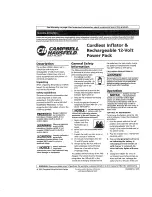
3
HOW TO USE THE G83
LOCKBOLTS
After selecting the proper pulling head and attaching it securely to the G83, connect the air line to the tool. Place the lockbolt pin into the workpiece
and place the collar over the pintail. It may be necessary to hold the lockbolt in the application to prevent it from backing out when placing the pulling
head over the serrations.
If you are using a non-self-releasing pulling head, make certain the collar is placed on the lockbolt pintail before placing the pulling head on the pin-
tail. Once the pintail is inserted into the pulling head the jaws will grip the pintail and prevent it from moving out of the front of the pulling head.
If there is sheet gap or a gap between the head of the lockbolt and the workpiece, it may require multiple stroking of the tool for complete installa-
tion. The pintail will eject through the rear of the tool when using H513 Series straight pulling heads. The pintail will eject through the rear of the H563
offset pulling head.
If the tool does not kick off the swaged collar, shims should be added behind the collet of the pulling head. See pulling head installation instructions.
BLIND BOLTS AND RIVETS
Insert the blind bolt or blind rivet stem into the proper pulling head until the head of the rivet is in contact with the pulling head nosepiece. This will
ensure full engagement between the jaws and the rivet stem and will prevent slippage.
Once the rivet stem is inserted in the pulling head, the rivet must be installed. The “stem stop” in the pulling head (H701 B-456) will prevent the man-
drel from moving back out the front of the head.
Insert the rivet into the application and pull the trigger to activate the tool. Upon the release of the trigger, the stem will eject to the rear of the tool
(when using the H701 B-456 straight pulling head). When using the H781-456 offset pulling head, the stem will eject through the offset pulling head
to the rear. When using the H753A-456 right angle pulling head, the stem will eject out the front.
MAINTENANCE AND REPAIR
The G83 has been manufactured to give maximum service with minimum care. In order that this may be accomplished, the following recommen-
dations should be followed:
1. The hydraulic system should be full of oil and free from air at all times.
2. Keep excessive moisture and dirt out of air supply to prevent wear of air valve, air cylinder and air piston.
3. Tool should be routinely inspected for oil leaks. Oil leaking around screws (49) indicates that a screw is loose or a Stat-O-Seal (50)
needs replacing. Oil leaking around the small by-pass hole near the base of the handle grip (1) would indicate worn or damaged O-
rings (19).
Use automatic transmission fluid Type “A” (no substitutes). Cherry® Aerospace recommends using, Dexron® III ATF.
DEXRON III OIL SAFETY DATA
FIRST AID
Skin:
Wash thoroughly with soap and water as soon as possible. Casual contact requires no immediate attention.
If irritation develops, consult a physician.
Ingestion:
Seek medical attention immediately. DO NOT INDUCE VOMITING.
Eyes:
Flush with copious amounts of water. If irritation develops, consult a physician.
Inhalation:
No significant adverse health effect are expected to occur on short term exposure. Remove from contaminated area.
Apply artificial respiration if needed. If unconscious, consult physician.
FIRE
Suitable extinguishing media:
CO
2
, dry powder, foam or water fog. DO NOT use water jets.
ENVIRONMENT
Waste Disposal:
In accordance with local, state and federal regulations.
Spillage:
Prevent entry into drains, sewers and water courses. Soak up with diatomaceous earth or other inert material. Store in
appropriate container for disposal.
HANDLING
Eye protection required. Protective gloves recommended. Chemically resistant boots and apron recommended. Use in well ventilated area.
COMBUSTIBILITY
Slightly combustible when heated above flash point. Will release flammable vapor which can burn in open or be explosive in
confined spaces if exposed to source of ignition.
STORAGE
Avoid storage near open flame or other sources of ignition.
PROPERTIES
Specific gravity
0.863
Weight per gallon
7.18 lbs.
Open flash point
>200°C (392°F)






























